engine overheat HYUNDAI ELANTRA 2021 Owners Manual
[x] Cancel search | Manufacturer: HYUNDAI, Model Year: 2021, Model line: ELANTRA, Model: HYUNDAI ELANTRA 2021Pages: 570, PDF Size: 52.21 MB
Page 88 of 570
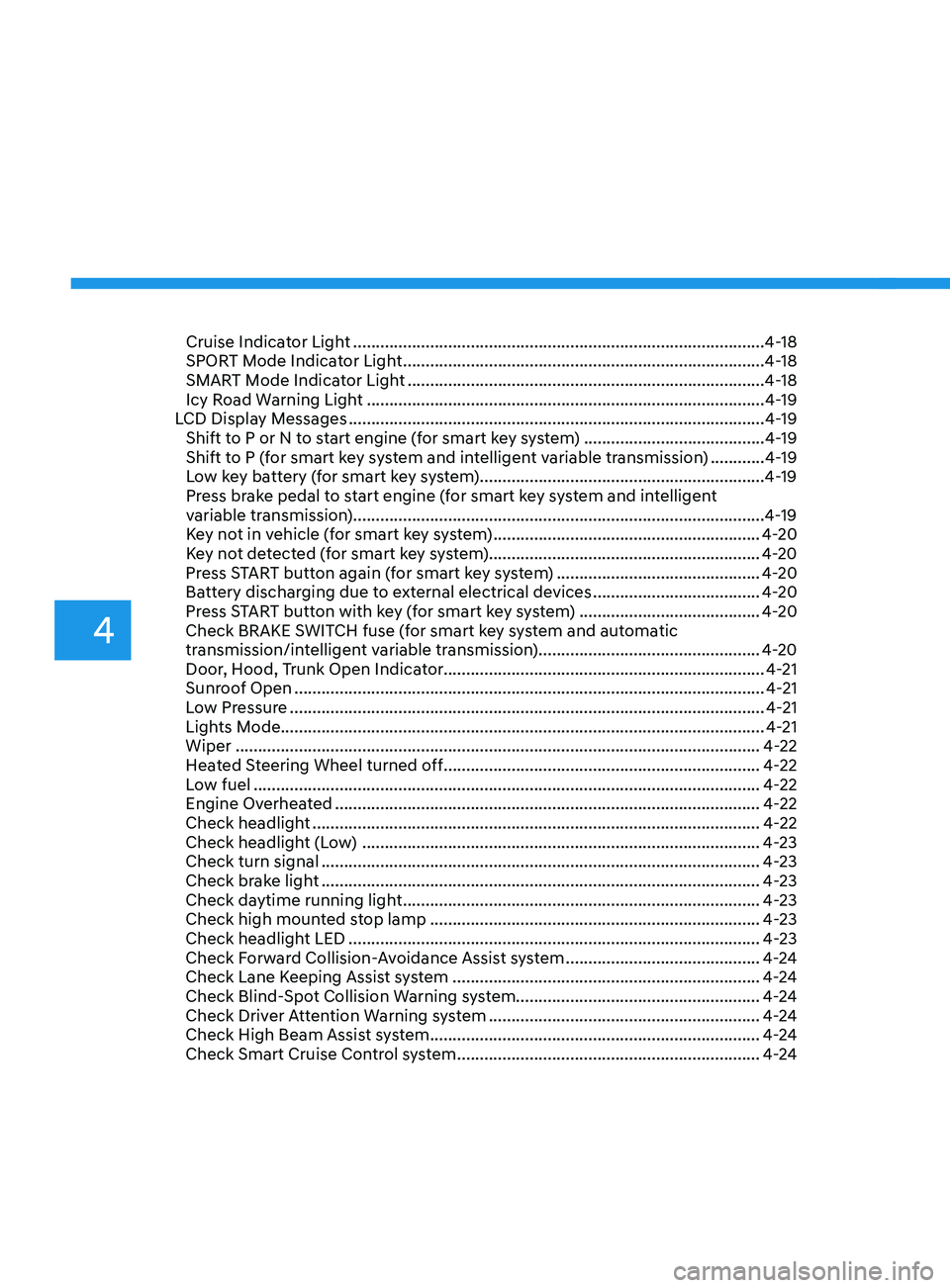
Cruise Indicator Light ........................................................................\
...................4-18
SPOR T Mode Indicator Light ........................................................................\
........ 4-
18
SMART Mode Indicator Light
........................................................................\
....... 4-
18
Icy Road Warning Light
........................................................................\
................ 4-
19
LCD Display Messages
........................................................................\
.................... 4-
19
Shift to P or N to start engine (for smart key system)
........................................ 4-
19
Shift to P (for smart key system and intelligent variable transmission)
............ 4-
19
Low key battery (for smart key system)...............................................................4-19
Press brake pedal to start engine (for smart key system and intelligent
variable transmission)......................................................................\
.....................4-19
Key not in vehicle (for smart key system)
........................................................... 4-20
K
ey not detected (for smart key system)............................................................ 4-20
Press START button again (for smart key system)
............................................. 4-
20
Battery discharging due to external electrical devices
..................................... 4-
20
Press START button with key (for smart key system)
........................................ 4-
20
Check BRAKE SWITCH fuse (for smart key system and automatic
transmission/intelligent variable transmission)................................................. 4-20
Door, Hood, Trunk Open Indicator....................................................................... 4-21
Sunroof Open
........................................................................\
................................ 4-
21
Low Pressure
........................................................................\
................................. 4-
21
Lights Mode........................................................................\
................................... 4-21
Wiper
........................................................................\
.....................................
.......4-22
Heated Steering Wheel turned off
...................................................................... 4-22
L
ow fuel
........................................................................\
.....................................
...4-22
Engine Overheated
........................................................................\
...................... 4-
22
Check headlight
........................................................................\
........................... 4-
22
Check headlight (Low)
........................................................................\
................ 4-
23
Check turn signal
........................................................................\
......................... 4-
23
Check brake light
........................................................................\
......................... 4-
23
Check daytime running light
........................................................................\
....... 4-
23
Check high mounted stop lamp
........................................................................\
. 4-
23
Check headlight LED
........................................................................\
................... 4-
23
Check Forward Collision-Avoidance Assist system
........................................... 4
-24
Check Lane Keeping Assist system
.................................................................... 4-2
4
Check Blind-Spot Collision Warning system...................................................... 4-24
Check Driver Attention Warning system
............................................................ 4
-24
Check High Beam Assist system
........................................................................\
. 4
-24
Check Smart Cruise Control system
................................................................... 4-2
4
4
Page 89 of 570
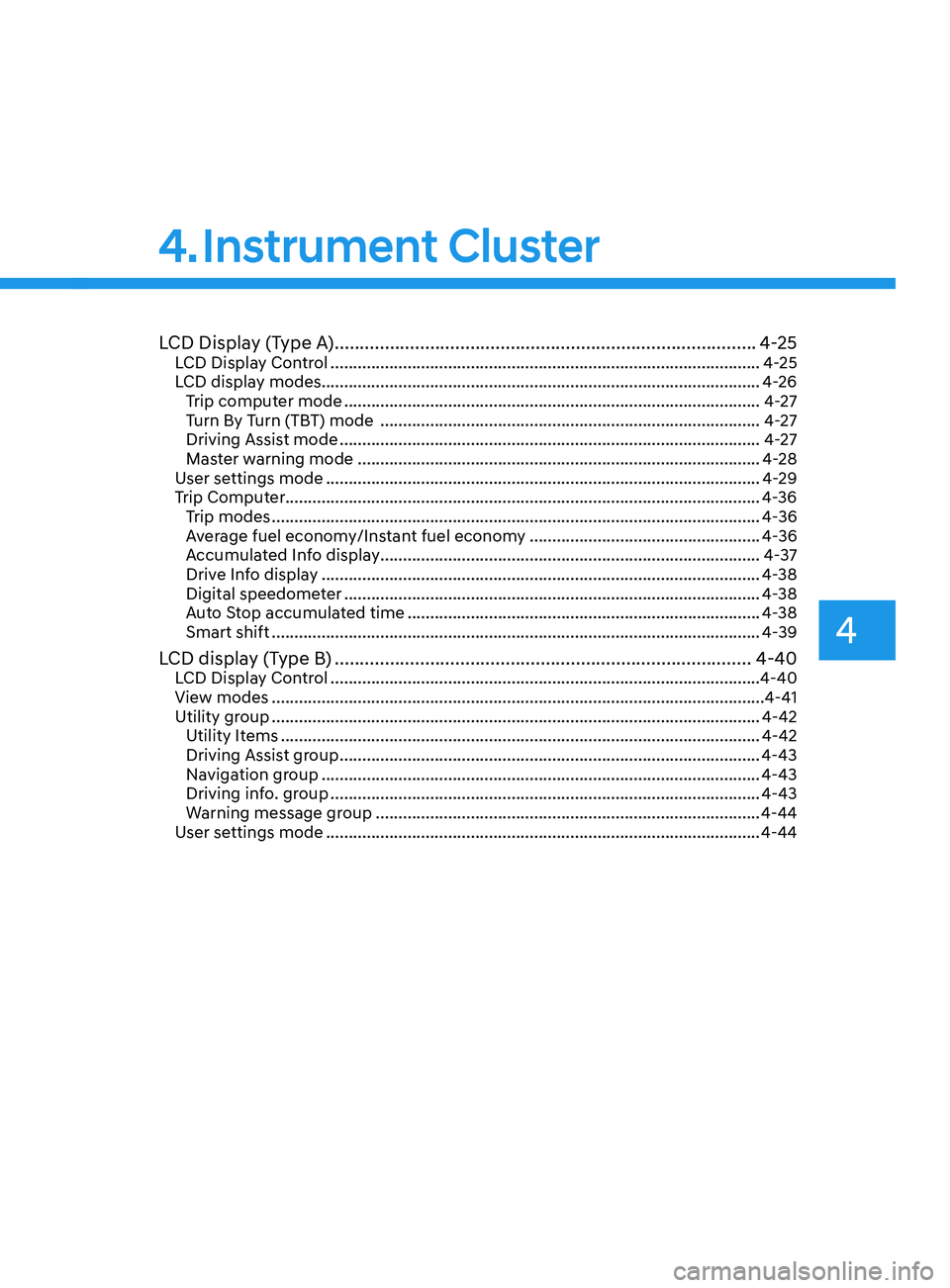
LCD Display (Type A) ........................................................................\
............4-25LCD Display Control ........................................................................\
....................... 4-25
L CD display modes........................................................................\
......................... 4-26Trip computer mode
........................................................................\
.................... 4-
27
Turn By Turn (TBT) mode
........................................................................\
............ 4-
27
Driving Assist mode
........................................................................\
..................... 4-
27
Master warning mode
........................................................................\
................. 4-
28
User settings mode
........................................................................\
........................ 4-
29
Trip Computer........................................................................\
................................. 4-36 Trip modes
........................................................................\
.................................... 4-
36
Average fuel economy/Instant fuel economy
................................................... 4-
36
Accumulated Info display
........................................................................\
............ 4-
37
Drive Info display
........................................................................\
......................... 4-
38
Digital speedometer
........................................................................\
.................... 4-
38
Auto Stop accumulated time
........................................................................\
...... 4-
38
Smart shift
........................................................................\
.................................... 4-
39
LCD display (Type B) ........................................................................\
...........4-40LCD Display Control ........................................................................\
....................... 4-40
View modes ........................................................................\
..................................... 4-4
1
Utility group
........................................................................\
.................................... 4-42
Utility It
ems
........................................................................\
.................................. 4-42
Driving Assis
t group
........................................................................\
..................... 4-43
Na
vigation group
........................................................................\
......................... 4-43
Driving in
fo. group
........................................................................\
....................... 4-43
W
arning message group
........................................................................\
............. 4-44
U
ser settings mode
........................................................................\
........................ 4-44
Cruise Indicator Light ........................................................................\
................... 4-18
SPORT Mode Indicator Light ........................................................................\
........ 4-18
SMART Mode Indicator Light ........................................................................\
....... 4-18
Icy Road Warning Light ........................................................................\
................ 4-19
LCD Display Messages ........................................................................\
.................... 4-19
Shift to P or N to start engine (for smart key system) ........................................ 4-19
Shift to P (for smart key system and intelligent variable transmission) ............ 4-19
Low key battery (for smart key system)...............................................................4-19
Press brake pedal to start engine (for smart key system and intelligent
variable transmission)......................................................................\
.....................4-19
Key not in vehicle (for smart key system) ...........................................................4-20
Key not detected (for smart key system)............................................................ 4-20
Press START button again (for smart key system) ............................................. 4-20
Battery discharging due to external electrical devices ..................................... 4-20
Press START button with key (for smart key system) ........................................ 4-20
Check BRAKE SWITCH fuse (for smart key system and automatic
transmission/intelligent variable transmission)................................................. 4-20
Door, Hood, Trunk Open Indicator....................................................................... 4-21
Sunroof Open ........................................................................\
................................ 4-21
Low Pressure ........................................................................\
................................. 4-21
Lights Mode........................................................................\
................................... 4-21
Wiper ........................................................................\
............................................ 4-22
Heated Steering Wheel turned off ...................................................................... 4-22
Low fuel ........................................................................\
........................................ 4-22
Engine Overheated ........................................................................\
...................... 4-22
Check headlight ........................................................................\
........................... 4-22
Check headlight (Low) ........................................................................\
................ 4-23
Check turn signal ........................................................................\
......................... 4-23
Check brake light ........................................................................\
......................... 4-23
Check daytime running light ........................................................................\
....... 4-23
Check high mounted stop lamp ........................................................................\
. 4-23
Check headlight LED ........................................................................\
................... 4-23
Check Forward Collision-Avoidance Assist system ........................................... 4-24
Check Lane Keeping Assist system .................................................................... 4-24
Check Blind-Spot Collision Warning system...................................................... 4-24
Check Driver Attention Warning system ............................................................ 4-24
Check High Beam Assist system ........................................................................\
. 4-24
Check Smart Cruise Control system ................................................................... 4-24
4. Instrument Cluster
4
Page 92 of 570
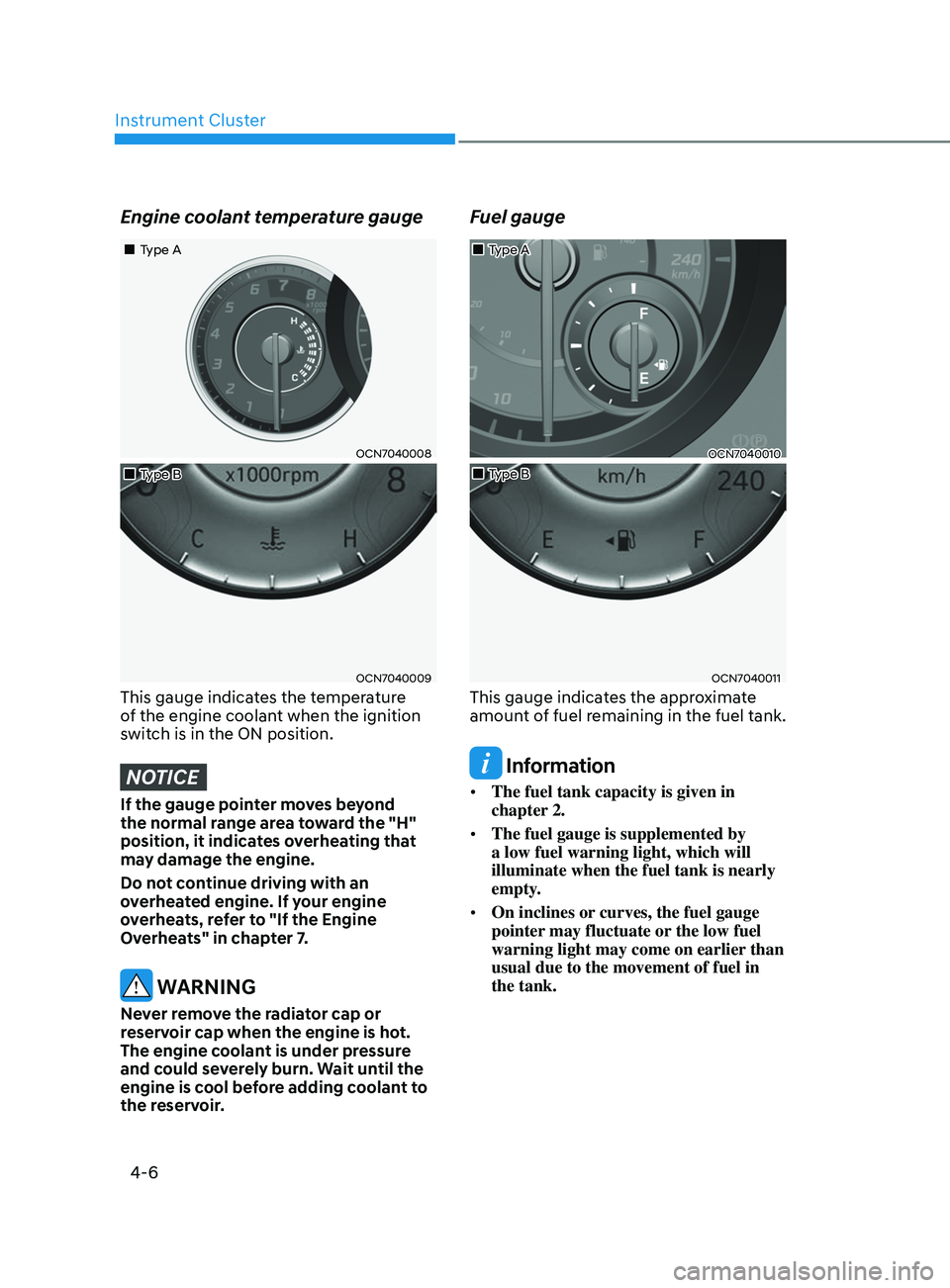
Instrument Cluster
4-6
Engine coolant temperature gauge
OCN7040008
OCN7040009
„„Type A
„
„Type B
This gauge indicates the temperature
of the engine coolant when the ignition
switch is in the ON position.
NOTICE
If the gauge pointer moves beyond
the normal range area toward the "H"
position, it indicates overheating that
may damage the engine.
Do not continue driving with an
overheated engine. If your engine
overheats, refer to "If the Engine
Overheats" in chapter 7.
WARNING
Never remove the radiator cap or
reservoir cap when the engine is hot.
The engine coolant is under pressure
and could severely burn. Wait until the
engine is cool before adding coolant to
the reservoir.
Fuel gauge
OCN7040010
OCN7040011
„„Type B
„
„Type A
This gauge indicates the approximate
amount of fuel remaining in the fuel tank.
Information
•
The fuel tank capacity is given in
chapter 2.
• The fuel gauge is supplemented by
a low fuel warning light, which will
illuminate when the fuel tank is nearly
empty.
• On inclines or curves, the fuel gauge
pointer may fluctuate or the low fuel
warning light may come on earlier than
usual due to the movement of fuel in
the tank.
Page 108 of 570
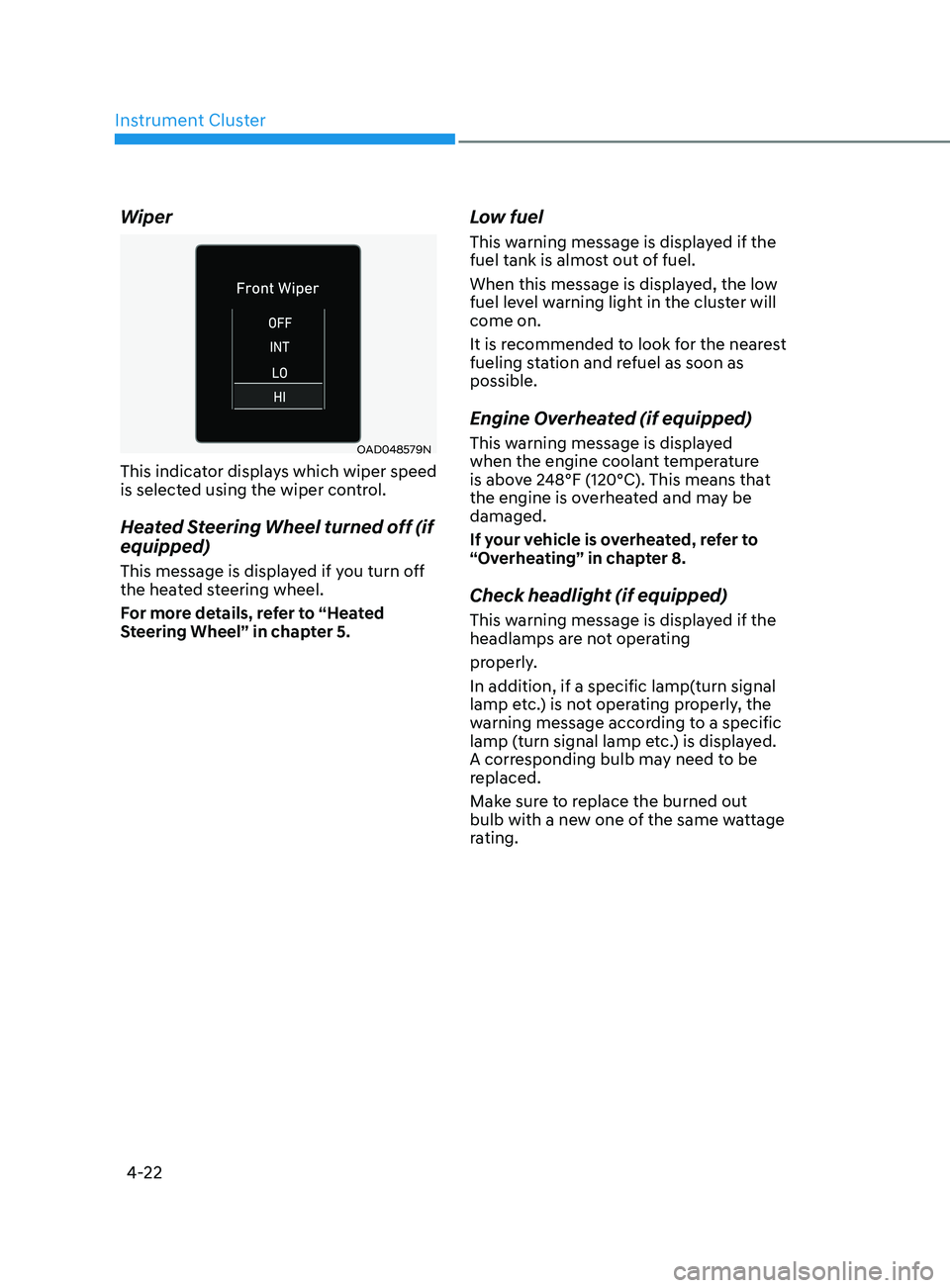
Instrument Cluster
4-22
Wiper
OAD048579N
This indicator displays which wiper speed
is selected using the wiper control.
Heated Steering Wheel turned off (if
equipped)
This message is displayed if you turn off
the heated steering wheel.
For more details, refer to “Heated
Steering Wheel” in chapter 5.
Low fuel
This warning message is displayed if the
fuel tank is almost out of fuel.
When this message is displayed, the low
fuel level warning light in the cluster will
come on.
It is recommended to look for the nearest
fueling station and refuel as soon as
possible.
Engine Overheated (if equipped)
This warning message is displayed
when the engine coolant temperature
is above 248°F (120°C). This means that
the engine is overheated and may be
damaged.
If your vehicle is overheated, refer to
“Overheating” in chapter 8.
Check headlight (if equipped)
This warning message is displayed if the
headlamps are not operating
properly.
In addition, if a specific lamp(turn signal
lamp etc.) is not operating properly, the
warning message according to a specific
lamp (turn signal lamp etc.) is displayed.
A corresponding bulb may need to be
replaced.
Make sure to replace the burned out
bulb with a new one of the same wattage
rating.
Page 225 of 570
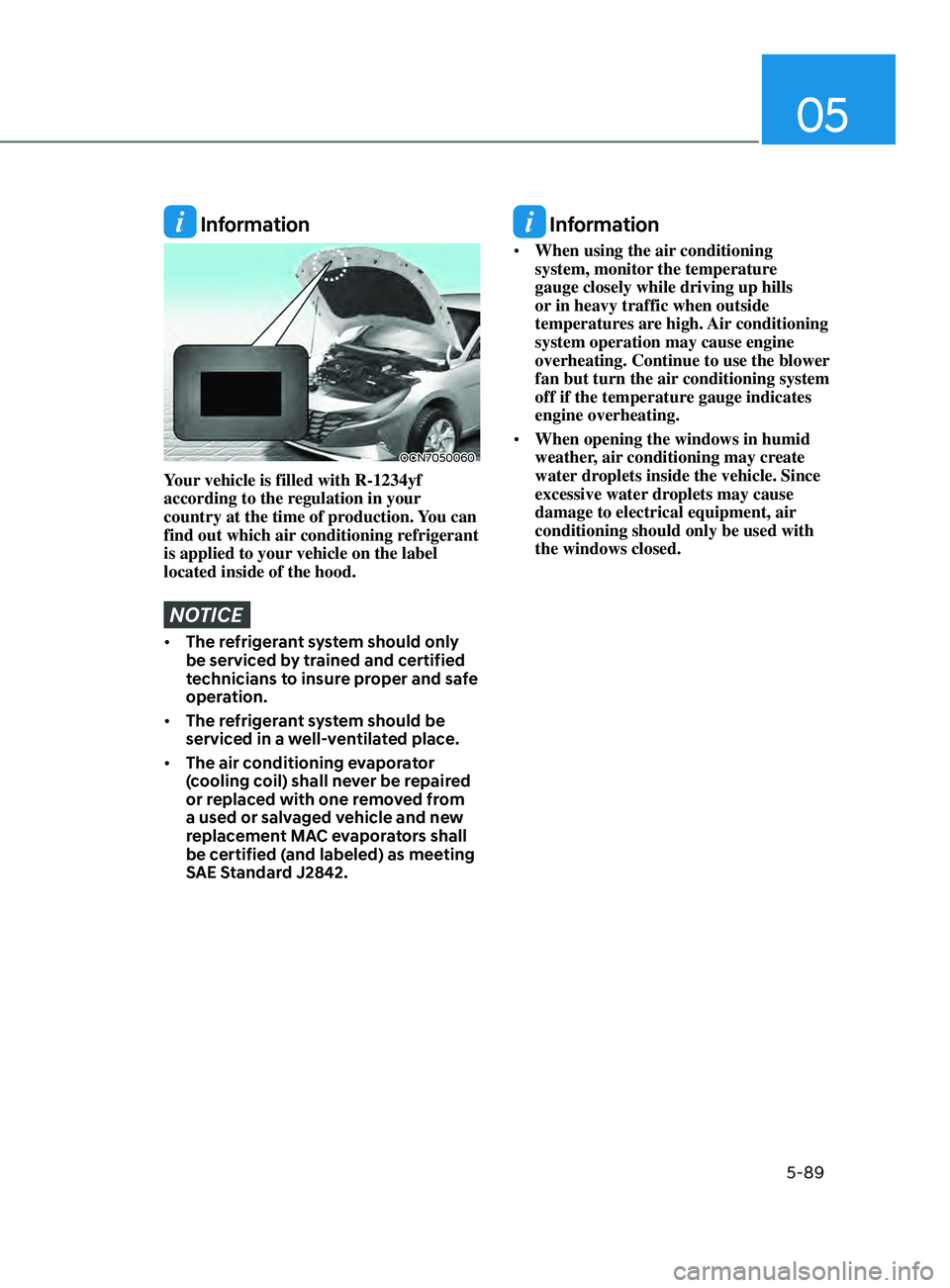
05
5-89
Information
OCN7050060
Your vehicle is filled with R-1234yf
according to the regulation in your
country at the time of production. You can
find out which air conditioning refrigerant
is applied to your vehicle on the label
located inside of the hood.
NOTICE
• The refrigerant system should only
be serviced by trained and certified
technicians to insure proper and safe
operation.
• The refrigerant system should be
serviced in a well-ventilated place.
• The air conditioning evaporator
(cooling coil) shall never be repaired
or replaced with one removed from
a used or salvaged vehicle and new
replacement MAC evaporators shall
be certified (and labeled) as meeting
SAE Standard J2842.
Information
• When using the air conditioning
system, monitor the temperature
gauge closely while driving up hills
or in heavy traffic when outside
temperatures are high. Air conditioning
system operation may cause engine
overheating. Continue to use the blower
fan but turn the air conditioning system
off if the temperature gauge indicates
engine overheating.
• When opening the windows in humid
weather, air conditioning may create
water droplets inside the vehicle. Since
excessive water droplets may cause
damage to electrical equipment, air
conditioning should only be used with
the windows closed.
Page 237 of 570
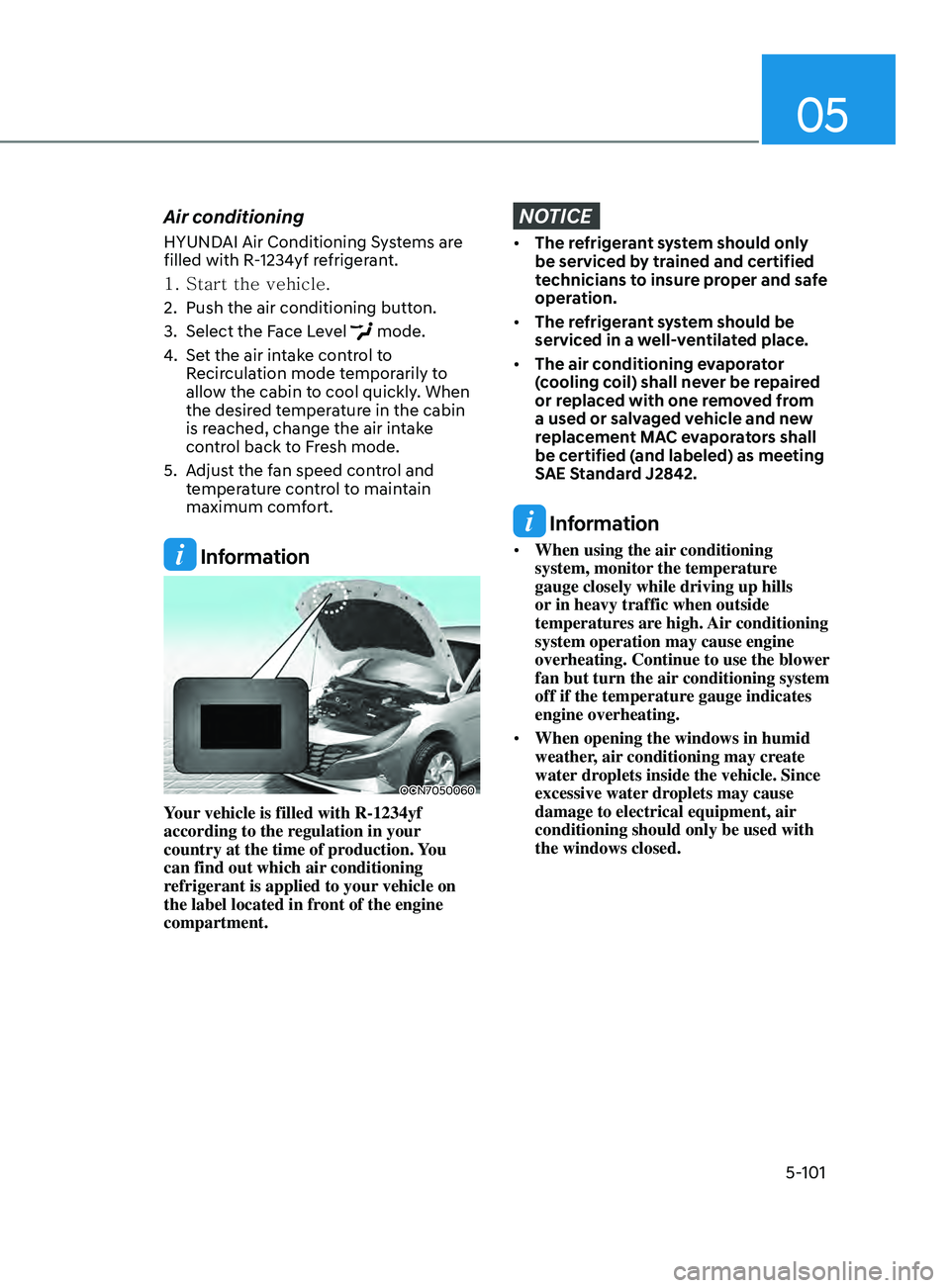
05
5-101
Air conditioning
HYUNDAI Air Conditioning Systems are
filled with R-1234yf refrigerant.
1.
Start the vehicle.
2.
Push the air conditioning button.
3.
Select the Face L
evel
mode.
4.
Set the air in
take control to
Recirculation mode temporarily to
allow the cabin to cool quickly. When
the desired temperature in the cabin
is reached, change the air intake
control back to Fresh mode.
5.
Adjus
t the fan speed control and
temperature control to maintain
maximum comfort.
Information
OCN7050060
Your vehicle is filled with R-1234yf
according to the regulation in your
country at the time of production. You
can find out which air conditioning
refrigerant is applied to your vehicle on
the label located in front of the engine
compartment.
NOTICE
• The refrigerant system should only
be serviced by trained and certified
technicians to insure proper and safe
operation.
• The refrigerant system should be
serviced in a well-ventilated place.
• The air conditioning evaporator
(cooling coil) shall never be repaired
or replaced with one removed from
a used or salvaged vehicle and new
replacement MAC evaporators shall
be certified (and labeled) as meeting
SAE Standard J2842.
Information
• When using the air conditioning
system, monitor the temperature
gauge closely while driving up hills
or in heavy traffic when outside
temperatures are high. Air conditioning
system operation may cause engine
overheating. Continue to use the blower
fan but turn the air conditioning system
off if the temperature gauge indicates
engine overheating.
• When opening the windows in humid
weather, air conditioning may create
water droplets inside the vehicle. Since
excessive water droplets may cause
damage to electrical equipment, air
conditioning should only be used with
the windows closed.
Page 249 of 570
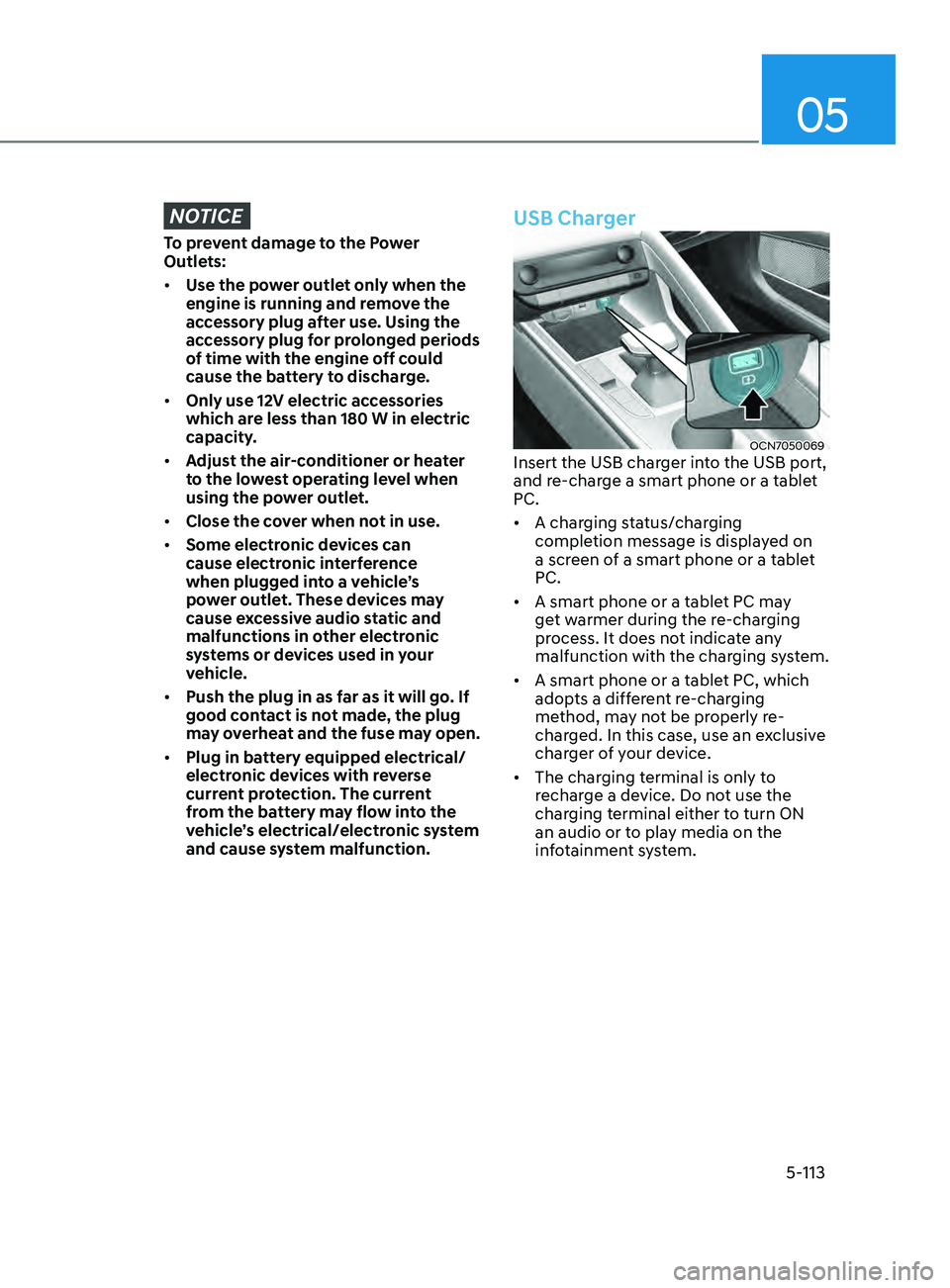
05
5-113
NOTICE
To prevent damage to the Power
Outlets:
• Use the power outlet only when the
engine is running and remove the
accessory plug after use. Using the
accessory plug for prolonged periods
of time with the engine off could
cause the battery to discharge.
• Only use 12V electric accessories
which are less than 180 W in electric
capacity.
• Adjust the air-conditioner or heater
to the lowest operating level when
using the power outlet.
• Close the cover when not in use.
• Some electronic devices can
cause electronic interference
when plugged into a vehicle’s
power outlet. These devices may
cause excessive audio static and
malfunctions in other electronic
systems or devices used in your
vehicle.
• Push the plug in as far as it will go. If
good contact is not made, the plug
may overheat and the fuse may open.
• Plug in battery equipped electrical/
electronic devices with reverse
current protection. The current
from the battery may flow into the
vehicle’s electrical/electronic system
and cause system malfunction.
USB Charger
OCN7050069Insert the USB charger into the USB port,
and re-charge a smart phone or a tablet
PC.
• A charging status/charging
completion message is displayed on
a screen of a smart phone or a tablet
PC.
• A smart phone or a tablet PC may
get warmer during the re-charging
process. It does not indicate any
malfunction with the charging system.
• A smart phone or a tablet PC, which
adopts a different re-charging
method, may not be properly re-
charged. In this case, use an exclusive
charger of your device.
• The charging terminal is only to
recharge a device. Do not use the
charging terminal either to turn ON
an audio or to play media on the
infotainment system.
Page 276 of 570
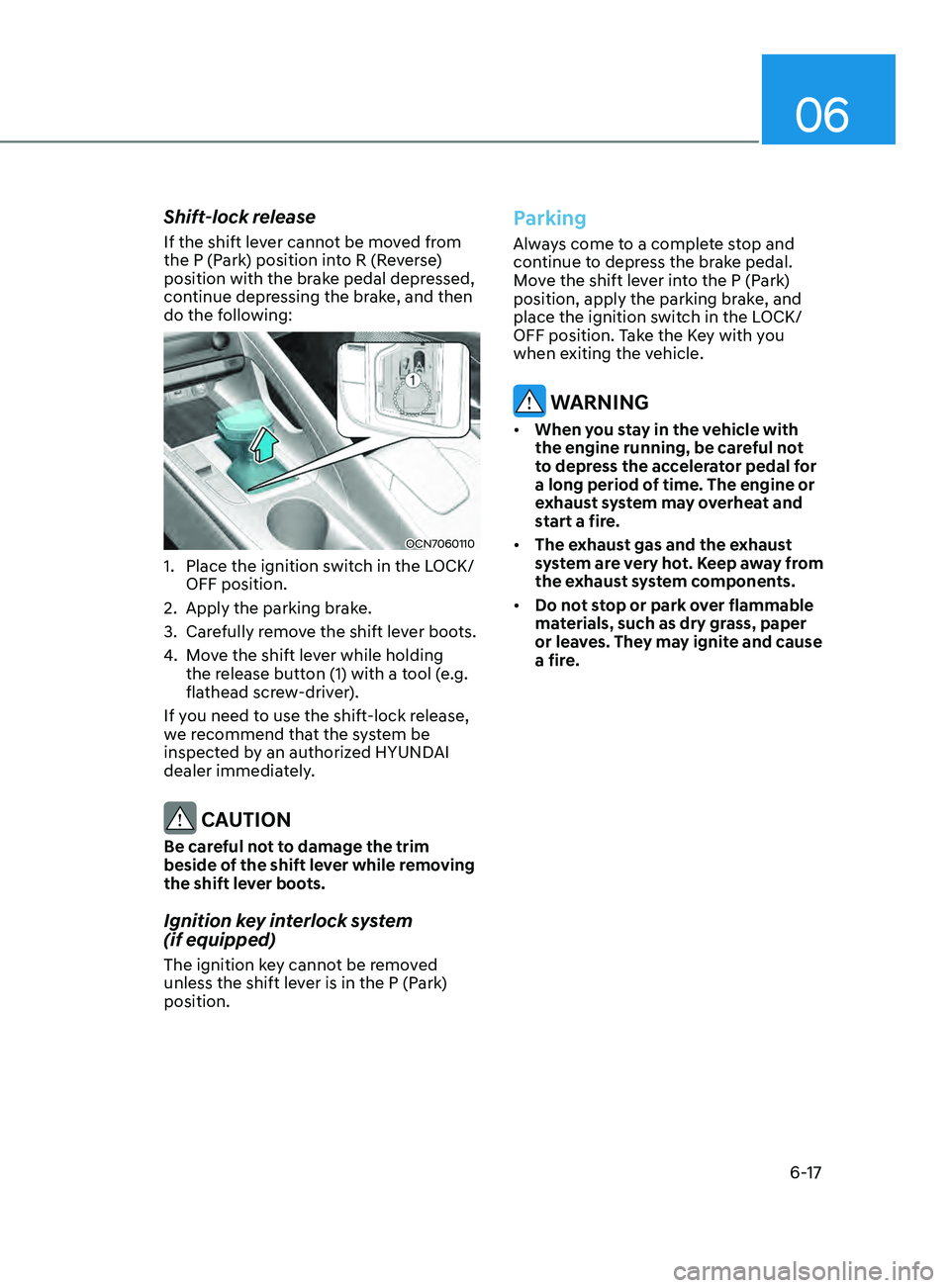
06
6-17
Shift-lock release
If the shift lever cannot be moved from
the P (Park) position into R (Reverse)
position with the brake pedal depressed,
continue depressing the brake, and then
do the following:
OCN7060110
1. Place the ignition switch in the LOCK/
OFF position.
2.
Apply the parking brak
e.
3.
Care
fully remove the shift lever boots.
4.
Mo
ve the shift lever while holding
the release button (1) with a tool (e.g.
flathead screw-driver).
If you need to use the shift-lock release,
we recommend that the system be
inspected by an authorized HYUNDAI
dealer immediately.
CAUTION
Be careful not to damage the trim
beside of the shift lever while removing
the shift lever boots.
Ignition key interlock system
(if equipped)
The ignition key cannot be removed
unless the shift lever is in the P (Park)
position.
Parking
Always come to a complete stop and
continue to depress the brake pedal.
Move the shift lever into the P (Park)
position, apply the parking brake, and
place the ignition switch in the LOCK/
OFF position. Take the Key with you
when exiting the vehicle.
WARNING
• When you stay in the vehicle with
the engine running, be careful not
to depress the accelerator pedal for
a long period of time. The engine or
exhaust system may overheat and
start a fire.
• The exhaust gas and the exhaust
system are very hot. Keep away from
the exhaust system components.
• Do not stop or park over flammable
materials, such as dry grass, paper
or leaves. They may ignite and cause
a fire.
Page 277 of 570
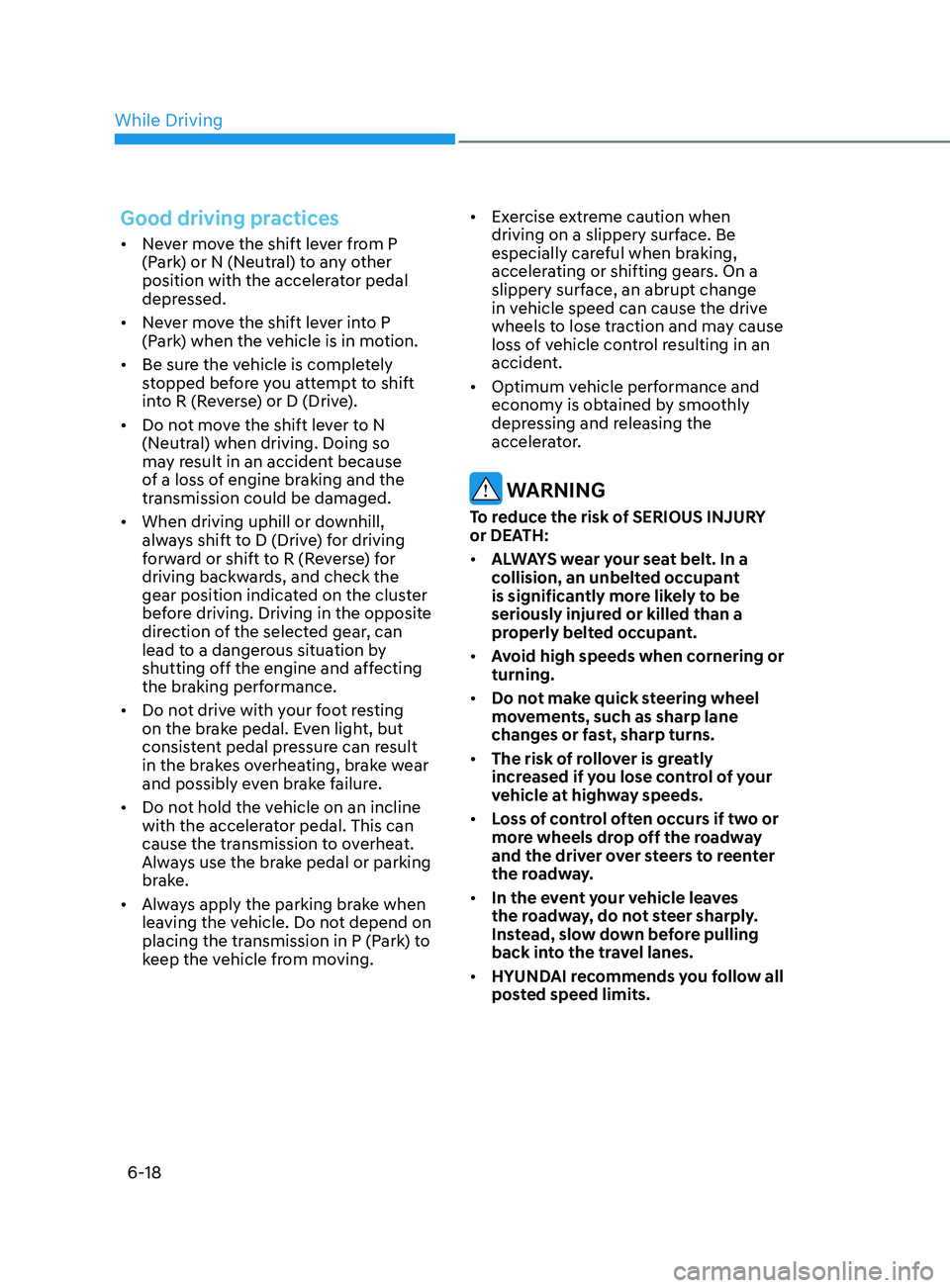
6-18
Good driving practices
• Never move the shift lever from P
(Park) or N (Neutral) to any other
position with the accelerator pedal
depressed.
• Never move the shift lever into P
(Park) when the vehicle is in motion.
• Be sure the vehicle is completely
stopped before you attempt to shift
into R (Reverse) or D (Drive).
• Do not move the shift lever to N
(Neutral) when driving. Doing so
may result in an accident because
of a loss of engine braking and the
transmission could be damaged.
• When driving uphill or downhill,
always shift to D (Drive) for driving
forward or shift to R (Reverse) for
driving backwards, and check the
gear position indicated on the cluster
before driving. Driving in the opposite
direction of the selected gear, can
lead to a dangerous situation by
shutting off the engine and affecting
the braking performance.
• Do not drive with your foot resting
on the brake pedal. Even light, but
consistent pedal pressure can result
in the brakes overheating, brake wear
and possibly even brake failure.
• Do not hold the vehicle on an incline
with the accelerator pedal. This can
cause the transmission to overheat.
Always use the brake pedal or parking
brake.
• Always apply the parking brake when
leaving the vehicle. Do not depend on
placing the transmission in P (Park) to
keep the vehicle from moving. •
Exercise extreme caution when
driving on a slippery surface. Be
especially careful when braking,
accelerating or shifting gears. On a
slippery surface, an abrupt change
in vehicle speed can cause the drive
wheels to lose traction and may cause
loss of vehicle control resulting in an
accident.
• Optimum vehicle performance and
economy is obtained by smoothly
depressing and releasing the
accelerator.
WARNING
To reduce the risk of SERIOUS INJURY
or DEATH:
• ALWAYS wear your seat belt. In a
collision, an unbelted occupant
is significantly more likely to be
seriously injured or killed than a
properly belted occupant.
• Avoid high speeds when cornering or
turning.
• Do not make quick steering wheel
movements, such as sharp lane
changes or fast, sharp turns.
• The risk of rollover is greatly
increased if you lose control of your
vehicle at highway speeds.
• Loss of control often occurs if two or
more wheels drop off the roadway
and the driver over steers to reenter
the roadway.
• In the event your vehicle leaves
the roadway, do not steer sharply.
Instead, slow down before pulling
back into the travel lanes.
• HYUNDAI recommends you follow all
posted speed limits.
While Driving
Page 278 of 570
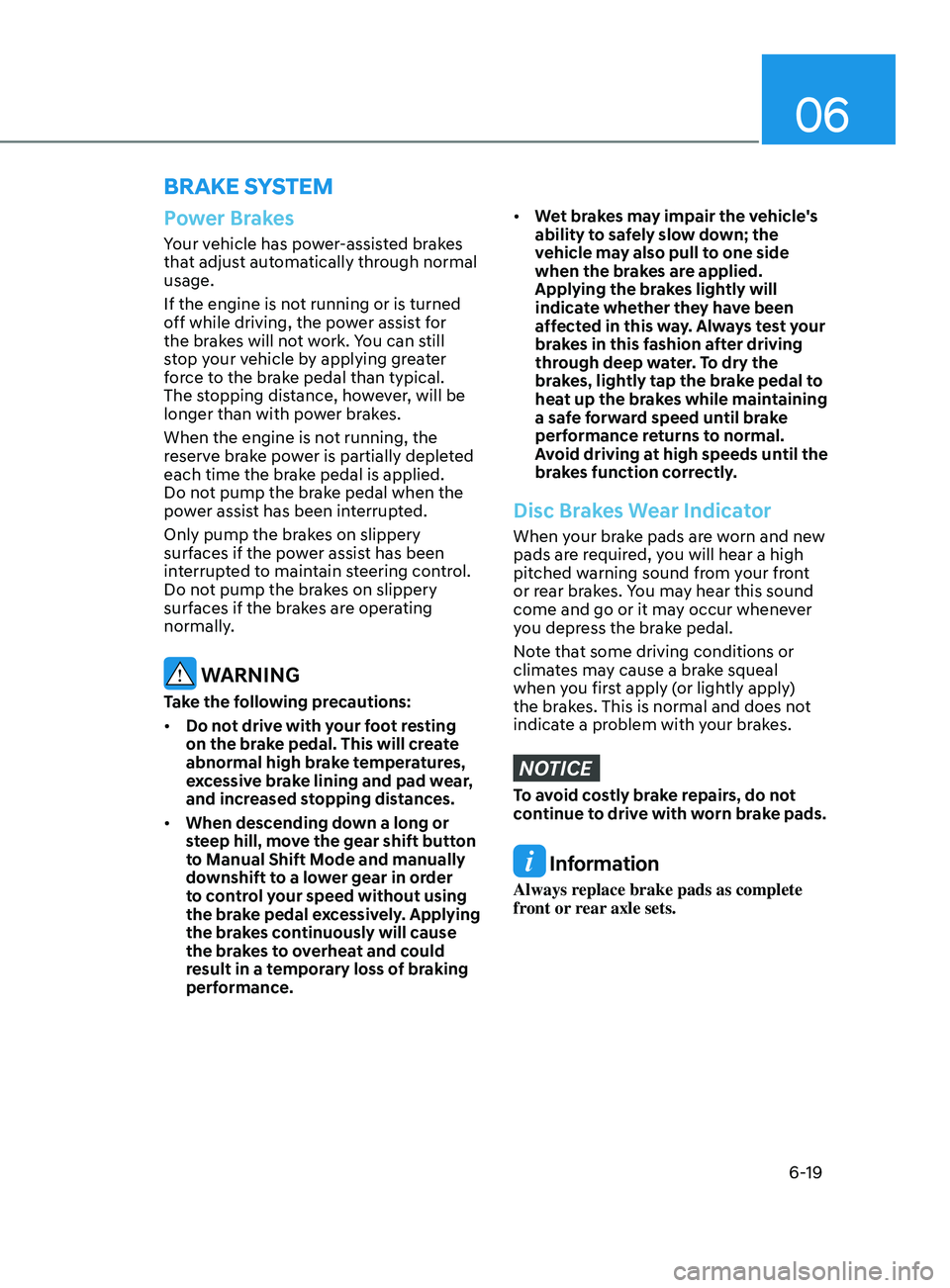
06
6-19
Brake SyStem
Power Brakes
Your vehicle has power-assisted brakes
that adjust automatically through normal
usage.
If the engine is not running or is turned
off while driving, the power assist for
the brakes will not work. You can still
stop your vehicle by applying greater
force to the brake pedal than typical.
The stopping distance, however, will be
longer than with power brakes.
When the engine is not running, the
reserve brake power is partially depleted
each time the brake pedal is applied.
Do not pump the brake pedal when the
power assist has been interrupted.
Only pump the brakes on slippery
surfaces if the power assist has been
interrupted to maintain steering control.
Do not pump the brakes on slippery
surfaces if the brakes are operating
normally.
WARNING
Take the following precautions:
• Do not drive with your foot resting
on the brake pedal. This will create
abnormal high brake temperatures,
excessive brake lining and pad wear,
and increased stopping distances.
• When descending down a long or
steep hill, move the gear shift button
to Manual Shift Mode and manually
downshift to a lower gear in order
to control your speed without using
the brake pedal excessively. Applying
the brakes continuously will cause
the brakes to overheat and could
result in a temporary loss of braking
performance.
• Wet brakes may impair the vehicle's
ability to safely slow down; the
vehicle may also pull to one side
when the brakes are applied.
Applying the brakes lightly will
indicate whether they have been
affected in this way. Always test your
brakes in this fashion after driving
through deep water. To dry the
brakes, lightly tap the brake pedal to
heat up the brakes while maintaining
a safe forward speed until brake
performance returns to normal.
Avoid driving at high speeds until the
brakes function correctly.
Disc Brakes Wear Indicator
When your brake pads are worn and new
pads are required, you will hear a high
pitched warning sound from your front
or rear brakes. You may hear this sound
come and go or it may occur whenever
you depress the brake pedal.
Note that some driving conditions or
climates may cause a brake squeal
when you first apply (or lightly apply)
the brakes. This is normal and does not
indicate a problem with your brakes.
NOTICE
To avoid costly brake repairs, do not
continue to drive with worn brake pads.
Information
Always replace brake pads as complete
front or rear axle sets.